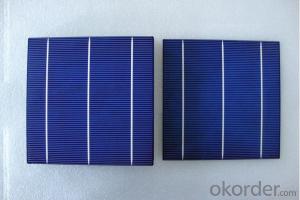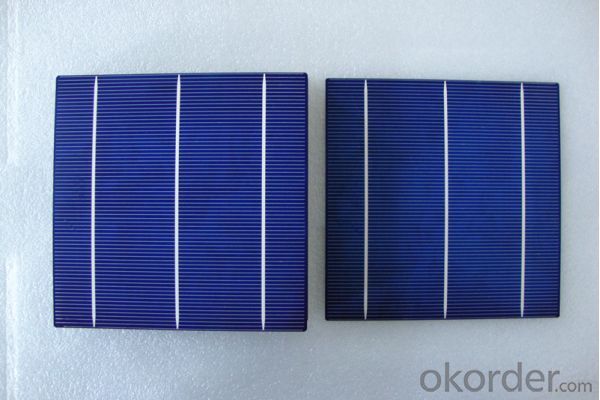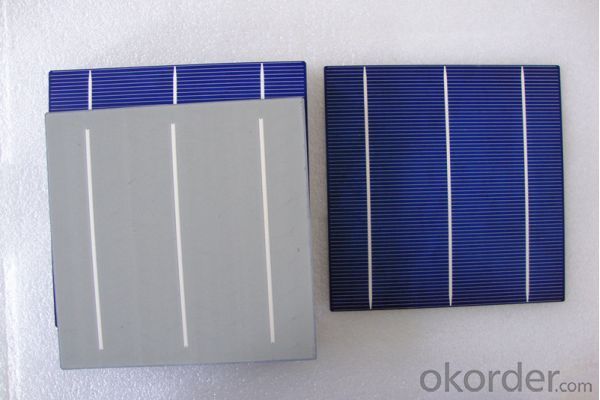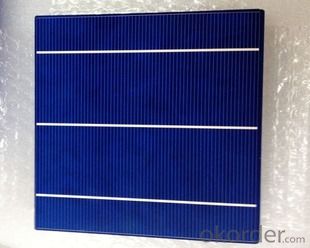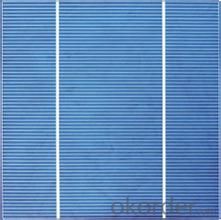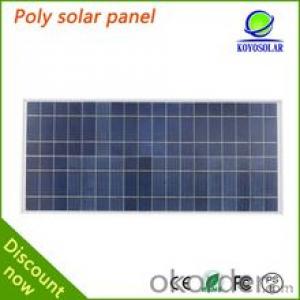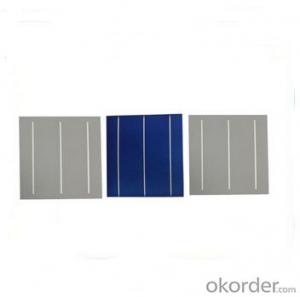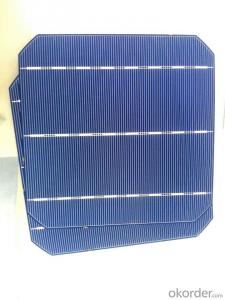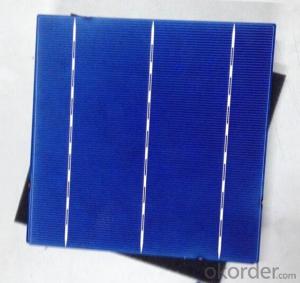12 Volt Solar Cells - Lower Price but Constant Good Quality Polycrystalline 156 Solar Cell High Efficiency
- Loading Port:
- Shanghai
- Payment Terms:
- TT or LC
- Min Order Qty:
- 1000 pc
- Supply Capability:
- 20000 pc/month
OKorder Service Pledge
OKorder Financial Service
You Might Also Like
| Packaging & Delivery | |
| Packaging Detail: | solar cell, 10boxes*100pcs in one carton, safe enough for transfer |
| Delivery Detail: | 5~7 days after receive deposit |
| Specifications | |
| solar cell for solar panel | |
| 1.16.8%~18.25% high efficiency | |
| 2.100% checked quality | |
| 3.ISO9001/ISO14001/TUV/UL | |
| 4.fast lead time | |
Product Description
POLY6'(156*156) Multicrystalline Silicon solar celle
Diagonal: 220mm±0.5mm
Thickness(Si): 200±20 μm
Dimension: 156mm×156mm±0.5mm
Front(-) Back(+)
Blue anti-reflecting coating (silicon nitride); Aluminum back surface field;
1.5mm wide bus bars; 2.0mm wide soldering pads;
Distance between bus bars: 51mm. Distance between bus bars :51mm.
| poly 156 cell Electrical Characteristics( solar cell for solar panel ) | ||||||||||||
| Efficiency(%) | 18 | 17.8 | 17.6 | 17.4 | 17.2 | 16.8 | 16.6 | 16.4 | 16.2 | 16 | 15.8 | 15.6 |
| Pmpp(W) | 4.33 | 4.29 | 4.24 | 4.19 | 4.14 | 4.09 | 4.04 | 3.99 | 3.94 | 3.9 | 3.86 | 3.82 |
| Umpp(V) | 0.53 | 0.527 | 0.524 | 0.521 | 0.518 | 0.516 | 0.514 | 0.511 | 0.509 | 0.506 | 0.503 | 0.501 |
| Impp(A) | 8.159 | 8.126 | 8.081 | 8.035 | 7.99 | 7.938 | 7.876 | 7.813 | 7.754 | 7.698 | 7.642 | 7.586 |
| Uoc(V) | 0.633 | 0.631 | 0.628 | 0.625 | 0.623 | 0.62 | 0.618 | 0.617 | 0.615 | 0.613 | 0.611 | 0.609 |
| Isc(A) | 8.709 | 8.677 | 8.629 | 8.578 | 8.531 | 8.478 | 8.419 | 8.356 | 8.289 | 8.22 | 8.151 | 8.083 |

. Warranty:
(1)5years quality assurance resulted from design, material and workmanship;
(2)Not less than 90% power output within 10years;
(3)Not less than 80%power output within 25years;
(4)Third-party insurance(Certificate Of Products Quality Warranty and Certificate Of Products Liability Insurance).
Advantages:
Lower price but constant good quality:
1. Excellent A grade solar cell from JA solar or our own lab;
2. Excellent backsheet from SFC, 3M;
3. EVA from Bridgestone;
4. Junction box with UL and TUV listed, IP65;
5. High transmission low iron tempered glass;
6. Solar panels with TUV, IEC, CE, ISO9001, ISO14001, CEC marked and ETL, MCS in processing;
PACKAGE AND SHIPPING ;
Material in stock can be produce (procedure 5-20days) right away after pre-payment confirmation. COSCO Mearsk MSC or othe ship to worldwide for safe shipping, don't worry about package damager or loss. It take 15-40 days to worldwide, Please note us your contact details include your phone number for easy contacting from shipping company officer.And we have about 12 years in solar panel production and exporting all over th world
Working Principle of Home Solar Cell
Home solar cell is the core part of the solar power system. The role of home solar cell is to convert the sun's light energy into electrical energy, and the DC output is stored in the battery. Home solar cell is the most important part of the solar system, the conversion rate and service life is an important factor in the decision whether to use the solar value.
Brief introduction of Home Solar Cell
1. Cell: High efficiency (over 16.5%) of monocrystalline silicon solar chip package, to ensure adequate power generation solar panels.
2. Glass: low Steel of suede glass (also called white glass), a thickness of 3.2mm, in the wavelength range of the spectral response of the solar cell (320-1100nm) light transmission rate of more than 91%, greater than 1200nm for IR light have a higher reflectivity. This glass also resistant to ultraviolet radiation from the sun, the light transmittance is not decreased.
3. EVA: using plus UV agents, antioxidants and the thickness of the curing agent is 0.78mm high EVA film as a sealant between the solar cell and a glass, TPT linking agent. It has a high light transmittance and resistance to aging.
4. TPT: solar cells on the back cover - fluorine plastic film is white, from the reflection of the sun, so the slight increase in the efficiency of the components, and because of having a high infrared emissivity, can reduce the operating temperature of the component, but also help to improve the efficiency of the module. Of course, this fluorine plastic film solar cell having a first packaging material required aging resistance, corrosion resistance, and the basic requirements, airtight and so on.
5. Border: used in high strength aluminum alloy frame, strong resistance to mechanical shock resistance. Solar Power is the highest value part. Its role is to the sun's radiation is converted to electrical energy stored in batteries or sent to, or promote the work load.
- Q: How much maintenance do solar cells require?
- Solar cells require very little maintenance. They are designed to be durable and can last for several decades with minimal upkeep. Routine maintenance typically involves cleaning the surface of the solar panels to ensure optimal sunlight absorption and occasionally checking for any damage or debris. Overall, solar cells are a low-maintenance energy solution.
- Q: How many years should I spend in the solar cell industry to be a good solar cells sales person?
- Experience matter, but not the years. As long as you are learning the solar cells knowledge everyday, you can be a good solar cells sales in just one year.
- Q: Can solar cells be used to power remote data collection systems?
- Yes, solar cells can be used to power remote data collection systems. Solar cells convert sunlight into electricity, making them an ideal renewable energy source to power data collection systems in remote areas where access to traditional power sources may be limited or unavailable. The energy harnessed by solar cells can be stored in batteries for continuous power supply, ensuring reliable operation of remote data collection systems.
- Q: What are the advantages of monocrystalline silicon and polycrystalline silicon in solar power?
- no mechanical groove in the same area on the efficiency of 16%, using buried gate structure, mechanical groove in the 130 square centimeters of polycrystalline Battery efficiency of 15.8%. (1) monocrystalline silicon solar cells
- Q: How do solar cells perform in dusty environments?
- Solar cells performance in dusty environments can be significantly affected. The accumulation of dust on the surface of the cells reduces the amount of sunlight reaching the cells, leading to a decrease in their efficiency. Regular cleaning and maintenance are required to ensure optimal performance in such conditions.
- Q: How do solar cells perform in high pollution areas?
- Solar cells do not perform as efficiently in high pollution areas due to the reduced sunlight reaching the cells. Air pollution particles in the atmosphere can scatter and absorb sunlight, leading to a decrease in the amount of solar energy that reaches the solar cells. This reduces the overall performance and power output of solar cells in such areas.
- Q: Can solar cells store energy for later use?
- No, solar cells cannot directly store energy for later use. They can only convert sunlight into electricity in real-time. However, the generated electricity can be stored in batteries or other energy storage systems for later use.
- Q: What is the role of monitoring systems in solar cell systems?
- The role of monitoring systems in solar cell systems is to gather real-time data on the performance and efficiency of the solar cells. These systems help in identifying any issues or malfunctions in the system, allowing for prompt maintenance and repairs. Monitoring systems also provide valuable insights into the energy production, consumption, and overall system health, enabling optimization of solar power generation.
- Q: How do solar cells impact local economies?
- Solar cells can have a positive impact on local economies by creating jobs in the renewable energy sector, attracting investments, and reducing energy costs for businesses and households. Additionally, the deployment of solar cells can stimulate economic growth through increased demand for related goods and services, ultimately contributing to the development of sustainable and resilient local economies.
- Q: What is the future of solar cells?
- The future of solar cells looks promising as advancements in technology continue to improve their efficiency, affordability, and scalability. With ongoing research and development, we can expect solar cells to become even more efficient in converting sunlight into electricity, allowing for increased energy production. Additionally, innovations such as flexible and transparent solar cells may expand their applications beyond traditional rooftops and solar farms. As the world's demand for renewable energy grows, solar cells are likely to play a crucial role in meeting our energy needs and transitioning towards a sustainable future.
Send your message to us
12 Volt Solar Cells - Lower Price but Constant Good Quality Polycrystalline 156 Solar Cell High Efficiency
- Loading Port:
- Shanghai
- Payment Terms:
- TT or LC
- Min Order Qty:
- 1000 pc
- Supply Capability:
- 20000 pc/month
OKorder Service Pledge
OKorder Financial Service
Similar products
Hot products
Hot Searches
Related keywords
